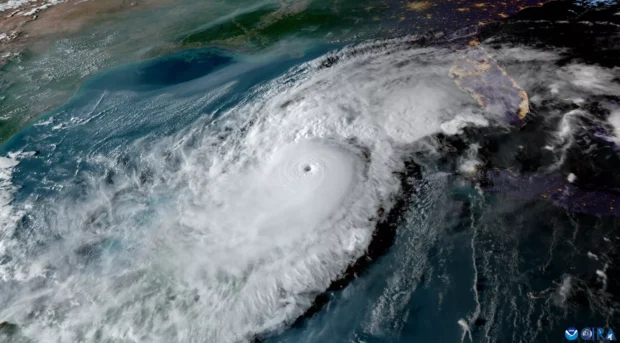The forecasts of above-average activity anticipated for the 2024 Atlantic hurricane season were on point as 18 named storms were recorded, according to an overview by the National Environmental Satellite, Data and Information Service.
Eleven storms became hurricanes, with five becoming major hurricanes (Category 3 or higher on the Saffir-Simpson Hurricane Wind Scale).
Five hurricanes made landfall in the U.S., with two making landfall as major hurricanes.
Though the season runs from June 1 to Nov. 30, tropical and subtropical cyclone formation can occur at any time, the agency said.
The 2024 Atlantic hurricane season had its slowest start since 2014, due to a large stationary heat dome over Central America and Mexico.
The season’s first named storm, Tropical Storm Alberto, formed in the western Gulf of Mexico on June 19, making landfall on the northeastern coast of Mexico the following day.
Hurricane Beryl came next, the earliest Atlantic basin Category-5 hurricane on record in a season and the strongest June and July hurricane on record in the basin, the NESDI said.
Beryl affected parts of the Caribbean, the Yucatán Peninsula, and the Gulf Coast of the United States, causing moderate storm surge flooding across parts of Texas and Louisiana after making landfall near Matagorda, Texas, as a Category-1 storm.
A nearly three week period of inactivity followed in the Atlantic basin due to the Saharan air layer, which suppresses tropical activity, according to the weather analysis agency.
Hurricane Francine formed on Sept. 9, making landfall in Louisiana as a Category 2 system on Sept. 11.
A flurry of activity followed with four systems developing during the final week of September, starting with Hurricane Helene making landfall as a Category-4 storm on the Florida Gulf Coast on Sept. 26.
The storm caused catastrophic flooding across the southern Appalachians, widespread wind damage from the Gulf Coast to the North Carolina mountains and storm surge flooding along portions of western Florida, the agency stated.
Preliminary data indicate that Helene was the strongest hurricane on record to strike the Big Bend region of Florida, the deadliest Atlantic hurricane since Maria in 2017 and the deadliest hurricane to affect the continental United States since Hurricane Katrina in 2005, with more than 150 direct fatalities, the majority of which occurred in North Carolina and South Carolina.
Hurricane Helene marked the first time ever that the National Hurricane Center forecasted a system to become a major hurricane before it became a tropical depression or tropical storm.
Early October saw the formations of Hurricanes Leslie and Milton and Kirk, which marked the first time on record that there were three simultaneously active hurricanes in the Atlantic basin after September.
Hurricane Milton underwent explosive rapid intensification within the Gulf of Mexico to become the second Category 5 hurricane of the season, making 2024 the first Atlantic hurricane season since 2019 to feature multiple Category 5 hurricanes.
Milton made landfall on the west coast of Florida on Oct. 9, less than two weeks after Hurricane Helene devastated the state’s Big Bend region, resulting in a tornado outbreak that produced 19 tornadoes, and caused torrential rainfall and localized flooding with total rainfall amounts of 10 to 15 inches (and higher), weather data showed.
Milton became the first Atlantic hurricane since Hurricane Wilma to reach a pressure below 900 mb (26.58 inHg) and the second-most intense tropical cyclone ever recorded over the Gulf of Mexico, only after Hurricane Rita, the agency noted.
The thirteenth named storm, ninth hurricane, fourth major hurricane, and second Category 5 hurricane of the 2024 Atlantic hurricane season, Milton is, so far, the strongest tropical cyclone worldwide in 2024.
The Atlantic seasonal activity fell within the predicted ranges for named storms and hurricanes issued by NOAA’s Climate Prediction Center in the August Hurricane Season Outlook, with an average season consisting of 14 named storms, seven hurricanes and three major hurricanes.
NOAA’s Hurricane Analysis and Forecast System aided National Hurricane Center (NHC) forecasters with improved predictions this season.
“During this active season in the Atlantic, NOAA’s National Weather Service, National Hurricane Center and NOAA Research hurricane scientists continued to advance our modeling and observation capabilities, preliminarily resulting in the most accurate NHC track forecasts ever issued at all forecast lead times in 2024,” said Michael Brennan, Ph.D., director, NOAA’s National Hurricane Center.
NHC implemented an experimental version of the cone graphic in 2024 that includes U.S. tropical storm and hurricane watches and warnings over inland areas. NHC scientists will evaluate public feedback on the usefulness of the experimental cone during the off-season months before NHC determines the future of the new cone graphic.
The 2025 hurricane season will officially begin on June 1. NOAA’s Climate Prediction Center, a division of the National Weather Service, will issue its initial 2025 seasonal outlook in May.





















 Unpacking a Consumer Intervenor’s Novel Idea
Unpacking a Consumer Intervenor’s Novel Idea  How One MGU Grew Fivefold When Capacity Fled Cat-Prone Property Markets
How One MGU Grew Fivefold When Capacity Fled Cat-Prone Property Markets  Why Insurance Telematics Integrations Fail
Why Insurance Telematics Integrations Fail  Viewpoint: Mapping Evolving Regulatory Terrain for MGAs, MGUs and Other DUAEs
Viewpoint: Mapping Evolving Regulatory Terrain for MGAs, MGUs and Other DUAEs 




